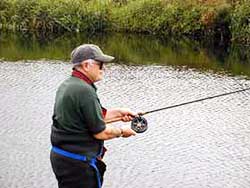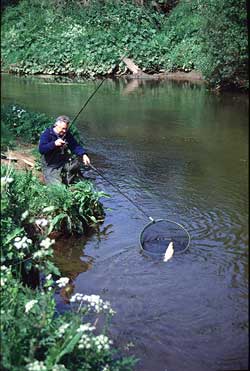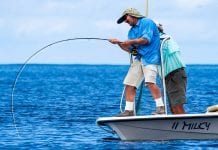| |||
| FLOAT FISHING Part Six – Waggler Fishing on Rivers – Casting, Controlling & Feeding In part five of Float Fishing I introduced you to waggler float choice and set up for the most encountered river scenarios. In this part I will be showing you how cast and control the river waggler and how to feed successfully. Getting ready As with stillwater waggler fishing getting yourself organised to fish is very important. It is often beneficial to fish the river waggler from a standing position so make sure you have everything you want close to hand so you are not fumbling or bending unnecessarily. Set up two rod rests to hold your rod in while feeding and baiting up. They should be set at waist height beside you on your rod arm side so you can easily place the rod in them between casts. If you are using a bait waiter set it up on the opposite side of you to your rod rests with your bait, catapult and disgorger on it. If you are using a bait apron fill the pouch with maggots and keep your catapult in there too. Bait aprons normally have additional pockets to keep ‘bits’ in. Have a disgorger in one of them plus some additional hook lengths. Finally make sure your landing net is set up and is within easy reach.
Casting Casting is much like with a stillwater waggler. As discussed in part 5 the float should be heavy enough to overcast your starting point in the water so you can draw the float back onto the correct line. The starting point is the beginning of the trot. Feather the cast as the float is about to land by lightly dabbing your finger on to the spool with a finger of your rod holding hand so that the bait and dropper shot overtake the float in the air and land lightly on the surface in a straight line. Practice will prevent you from allowing the whole set up to land in a tangled heap. In order to gain the best presentation and maximum control the cast should ideally be just to your downstream side allowing the float to trot away from you taking line from the reel continuously. When the wind is blowing quite briskly downstream the further downstream you may have to cast to combat its effect. I will elaborate more on this later, when discussing control. Feeding Introducing free bait to a river with any sort of current is a matter of judgement. The feed is not going to go straight down to the bottom, but will be carried downstream. You need to judge where to introduce the feed so that it reaches the bottom about halfway to two thirds down the length of the swim you are trotting. Keep in mind also that, due to friction, the flow of water will be slower nearer the river bed than it is on the surface so your bait will fall in an arc, not at a constant drop.
Make sure your hook is baited and place your rod on the rod rests next to you. Introduce a pouch of maggots into the swim, then quickly, but not hurriedly, make your cast. Your hook bait should then be travelling down in the vicinity of a few loose offerings ready to tempt any fish searching for a meal. The line you feed, that is the distance away from your bank, depends on how far across the river you expect to catch the fish. You need to decide which is the most likely area of the river that the fish will be occupying and feed that line constantly. Try and keep the feed going down the same line, creating a bait trail of about a three to five feet across. This helps to keep the fish reasonably spaced and to stop them from spooking when you hook one. As you feed and fish, take note where in the swim you are getting most bites. If bites start well but then become less frequent, try setting the float shallower. It may not be that the fish have stopped feeding, but that they have reacted to your constant bait trail and followed it up towards you, coming up in the water as they do so and intercepting your bait on the drop. Your hookbait could be passing unnoticed beneath the majority of the shoal. Don’t be afraid to keep experimenting with depth as the fish will change where in the swim they are feeding throughout a session. Control A key decision to be made that will greatly affect the control you have over the float is whether or not to fish with a floating or sinking line. Several things determine what you should do. Rivers that have very little movement are best fished with a sinking line unless there is absolutely no breeze in which case you can get away with a floating line. Sink the line by over casting your start point, dip your rod tip under the water and reel the float back sharply to the fishing point. Once the flow of water is above negligible, then a floating line is the way to go providing the wind is blowing in any direction except downstream. More of that in a moment. Assuming that the wind is blowing across or upstream, then let the line float and pull off the reel as your waggler moves downstream. You may get a certain amount of bowing in the line, especially with a cross wind into your face, but this can easily be corrected by ‘mending’ the line. To do this you need to raise your rod and lift the bowing line off the water to a point about a yard above the float, then flick the line back into a straight line behind it. Doing this prevents the bow from becoming unmanageable and pulling the float off course. This is one of the reasons for fishing downstream of you. It is impossible to mend a line that is coming towards you or is going straight out. Now, how to combat a downstream wind. A downstream wind is the worst to cope with because it makes the line travel quicker than the current, pushing the line ahead of the float. This causes a floating line to bow to the downstream side of the float and hence will pull your float sideways giving a poor presentation. With a floating line you spend more time trying to mend the line than in watching the float. To combat a ‘downstreamer’ use a sinking line combined with a heavier than normal float that will not get dragged out of position so much. The line may still bow with the current but you should be able to cure this with only the occasional mend. You will find that the harder the wind is blowing the further downstream you may need to cast. This makes controlling the waggler easier, because you are creating a much straighter line between the rod tip and the float, reducing the scope in which the line can bow. That’s about it on the river waggler. Hopefully I have demonstrated what a versatile tool the waggler is and for me it’s one of the most enjoyable and active methods of fishing. Give it a try, I’m sure you will enjoy it too. In Part 7 of Float Fishing I will introduce the basic concepts of stickfloat fishing. See you then. |
Welcome!Log into your account















